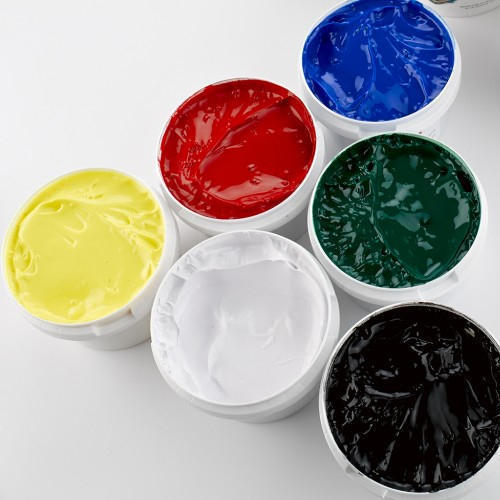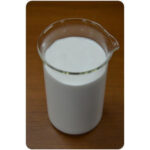
Plastisol Inks: Basic Information
Plastisol ink is a screen-printing ink that is use on textiles. Plastisol inks are the most popular inks for printing designs on clothes, and they’re especially good at producing opaque images on dark textiles.
PVC particles suspended in a plasticizing emulsion make up the ink, which will not dry if left on the screen for too long. After printing, garments do not need to be a wash & Plastisol inks do not dissolve in water.
For printing on colorful cloth, Plastisol inks suggest. Plastisol is highly opaque on lighter fabrics and, with careful care, may last for many years Plastisol inks do not dry; instead, they must be the cure. The cure may be done in an oven or with a flash dryer.
For thorough curing, most plastisol ink require a temperature of around 180 degrees Celsius (350 degrees Fahrenheit). Plastisol ink , rather than soaking into the fibres, sits on top of the cloth, giving the print a raised, plasticized appearance.
Other inks have a gentler feel to them. It’s also utilize for printing with a high density (HD) resolution. Multiple coats of ink are applie in this technique, with a curing stage in between each coat.
Choosing the “ideal” mesh for your plastisol ink printing needs
might be difficult with so many different meshes to pick from. If you’re looking for a screen mesh, use the following information as a guide:
- 30–38 mesh for Glitter Plastisol Ink.
- 60–85 mesh for athletic prints.
- 60–110 mesh for fleece items.
- 60–85 mesh with puff inks.
- 60–85 mesh for metallic plastisol ink
- Plastisol Super Opaque/Bleed Resistant: 60–85 mesh
- 60–85 mesh Hot-Split Heat Transfers
- Prints on Plastisol: 110–125 mesh
- Plastisol Printing: Multi-Color, Wet-on-Wet Mesh: 180 – 20 0 Mesh
- Printing on Nylon Jackets: 180 – 230 mesh
- 230–305 mesh for Simulated & 4-Color Process

Additives for Plastisol Ink
A word of warning about ink additives: Using the wrong additives or adding too much of an addition – even if it is the proper sort of additive – may easily disturb the chemical equilibrium of plastisol inks.
T-shirt ink that never dries correctly can be the outcome, a problem that may not until your client washes a garment and the design fades (i.e. color loss, adhesion, or cracking).
To avoid this problem, use only the additives advised by the manufacturer, and read and carefully follow the Technical Data Sheets for each ink and additive.
Mineral spirits should never be use with plastisol ink. Although mineral spirits make printing simpler at initially, they will eventually become obsolete.
What is plastisol Ink made of ?
PVC resin (a white powder) and plasticizer are the two main components in Plastisol ink (a thick, clear liquid). At normal temperatures, Plastisol ink will not dry or cure.
To cure effectively, they must be expose to temperatures between 300 and 330 degrees Fahrenheit (143 and 166 degrees Celsius) (dried). Plastisol ink is the most widely use ink in the garment printing business.
Plastisol ink for screen printing is simple to use, does not dry on the screen, is opaque on dark clothing, and adheres well to t-shirts, athletic jerseys, hoodies, heat transfers, and most fabrics.
Many things that can resist the heat necessary to cure the Plastisol ink and are porous enough to allow excellent ink adherence can be print using Plastisol ink. Unlike traditional dye materials, they do not color the threads of a cloth.
Plastisol screen printing ink wraps around the fibers and adheres to the cloth mechanically. Non-porous surfaces such as plastic, metal, wood, and glass will not adhere to screen printing plastisols.
They also won’t stick to water-resistant nylon without the addition of a bonding agent/catalyst.
Knowledge about Screen printing.
- Cleaning the Screen Frame
Mineral spirits or any of the different brand name screen washes available from your screen printing provider maybe use to clean plastisol ink from your screens.
When you’re doing screen printing for the day, use a press wash, but maintain the picture on the screen.
Remove plastisol and graphic ink from the screen and mesh with an ink degraded.
Screen and Digital also recommend reclaiming screens with a dip tank or a washout booth.
Plastisol Heat Transfer Printing Screen Printing
The majority of plastisol heat transfers are classified as either hot-split or cold-peel. When applying for hot-split transfers, the paper is removed from the garment as soon as the heat transfer press is opened.
The plastisol ink layer rips off from the paper transfer sheet, leaving some ink on the garment and some on the transfer paper.
Soft-hand direct printing is comparable to hot-split transfers. The heat transfer is allowed to cool before the paper is removed when using cold-peel transfers (usually around 30 seconds). The ink from the paper transfers completely to the clothing. Cold-peel transfers feature a glossy finish and are often used for athletic-style printing.
Some heat transfers can be separated or peeled hot or cold. Heat transfers are not as long-lasting as direct screen printing.
Can you cure plastisol ink with a heat press?
A heat press is similar to a conveyor drier but without a belt. Because it offers a constant heat source, a heat press is an excellent technique to cure inks.
While you’re using it, it keeps track of any temperature changes. A heat press will be great multi-purpose equipment if a company currently prints vinyl.
Curing using a heat press is easy and quick. Read the label for the curing temperature of plastisol ink and set the heat press to 20-30 degrees above that temperature.
Light to medium pressure should be use. Cover the print with a Teflon sheet. For 20-30 seconds, press the button. Make sure you run a wash test to make sure the ink is completely dry.
Does plastisol ink go bad ?
Although ink does not go bad, it does harden with time. This may be remedied by adding a curable reducer to the ink to bring it back to life.





